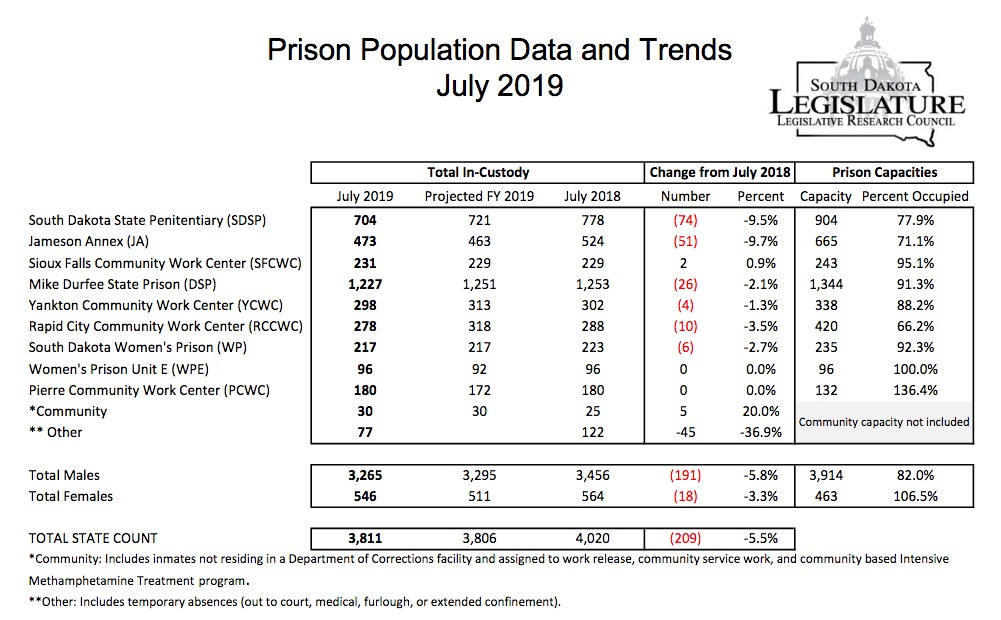In good news, fewer people are in jail!


According to the Legislative Research Council’s latest prison population report, South Dakota had 209 fewer people behind bars in July than it did in the same month last year. We’ve thus leveled off an apparent three-year bulge in our adult inmate population. The number of male prisoners was down 5.8%, while the number of female prisoners was down 3.3%.
Of course, we’d be housing even fewer prisoners if we listened to the ACLU and implemented their Smart Justice recommendations:
Instead of using an enormous amount of taxpayer funds to prosecute and incarcerate drug users, the ACLU of South Dakota’s recently released Blueprint for Smart Justice report advocates for a smarter approach and supports the use of treatment and diversion whenever possible. South Dakota needs to invest in vital services such as addiction treatment and mental health resources.
“Though drug use is undoubtedly a serious issue, we can’t incarcerate our way out of addiction,” said Libby Skarin, ACLU of South Dakota policy director. “It’s easy for officials to talk tough and introduce policies that add harsher penalties and more prison time. It’s much more difficult to recognize and act on the simple truth that our overemphasis on such enforcement deprives us of the chance to set up services that can eliminate crime in the first place, especially when it comes to crimes driven by addiction.”
Initiatives like drug courts have been successful in keeping offenders in communities while opening up avenues for them to get the treatment they need. Supporting and expanding alternatives to incarceration can solve the underlying causes of many addiction-related crimes and save taxpayer dollars.
Additionally, reclassifying ingestion as a misdemeanor and investing the resulting savings of state funds in diversion and treatment programs designed to combat addiction would go a long way in helping to solve the underlying problems leading to drug abuse.
“Reclassifying ingestion as a misdemeanor and investing the resulting savings of state funds in diversion and treatment programs designed to combat addiction would go a long way in helping to solve the underlying problems leading to drug abuse,” Skarin said [ACLU of South Dakota, press release, 2019.08.19].
Drug offenders make up 28% of the male inmate population and 64% of the female inmate population. 49% of the male inmates and 13% of the female inmates are in for violent crimes.
It would be interesting to see how much the County jail inmate population has risen. Anecdotal evidence suggests that judges are sentencing convicted persons to time in county jails for crimes that have traditionally been served in the state penn.
It would seem that becoming aware that 64% of the female prison population is a result of our archiac drug laws would be a real wake up call to any rational policy maker. Unfortunately, it also appears that rationality may have been replaced by magical thinking and personal greed, both effectively modeled by the current leader of the very Republican party that dominates the State legislative and executive branches as well as the State’s input into Congress.
Locking people up who use drugs to try to end pain or just feel good instead of locking up greedy, racist and xenophobic people who lie to the public and support harmful public policies (e.g. pro-gun, anti-environment, climate change denial, seperating children from families, and establishing prison-like concentration camps to dehumanize and incarcerate people seeking only safety, freedom and economic security for their families, etc, etc) for money and power in politics seems an upside down priority. End of rant.
Well, Thomas, the Brown County jail has been running over capacity lately. Yes, for a complete picture, we need data from the counties.
I wholeheartedly agree with BCB’s characterization of SD’s upside down priorities.
The ACLU’s Smart Justice Plan is, well, smart. As Ms. Skarin said, it would save taxpayers money, but that’s not really an interest of the SDGOP. They like to cut programs that aid middle and lower income folks, while lining their own pockets with taxpayer dollars.
The law ought to treat weed the same way it does underage drinking. Or better yet, treat it entirely the same as alcohol.
Apparently the most deadly legal product is neither of those. It’s tobacco and vaping products. Now there’s something to get politically excited about. Make marketing or selling those products to underage people a felony.